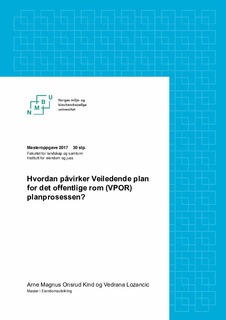| dc.contributor.advisor | Holsen, Terje | |
| dc.contributor.author | Lozancic, Vedrana | |
| dc.contributor.author | Kind, Arne Magnus Onsrud | |
| dc.coverage.spatial | Norway, Oslo | nb_NO |
| dc.date.accessioned | 2018-02-07T13:39:55Z | |
| dc.date.available | 2018-02-07T13:39:55Z | |
| dc.date.issued | 2017 | |
| dc.identifier.uri | http://hdl.handle.net/11250/2483311 | |
| dc.description.abstract | In view of the fact that in recent years new tools for area planning have been developed, which are not legally rooted in the Planning and Building Act, we have investigated how VPOR influences the planning process. Since fast and efficient planning and construction work is an overall goal of urban planning work in Oslo, we felt it was natural to look into how VPOR contributes in this regard. We wanted to investigate whether VPOR leads to shorter time and / or lower conflict levels in the planning process. For this reason we have investigated four projects, where two projects are in areas without, and two in areas with VPOR. The two projects located in the area of VPOR are located on Ensjø, while the other two are located in Torshov and in Nydalen.
The research program has been two-fold: both conflict level and time spent have been investigated through document analyzes and interviews. Thus, the study has been based on actual figures from the document analysis as well as what the informants themselves experienced. In order to give us a picture of how VPOR has influenced the planning process, we have tried to link the results from the document analysis and the interviews to relevant negotiation theory.
A natural thought would be that VPOR, which aims to establish the basis for good negotiations, will lead to more cooperation, and thus a lower level of conflict. However, we have seen that this is not necessarily the case. The study shows that areas with VPOR used shorter time in regulating process, but it did not have large impacts.
If VPOR is to lead to integration negotiations, certain prerequisites are required. An important finding in the task is the tendency for the number of case managers to correlate with time use and conflict level. In light of relevant negotiation theory, we have examined what may be the reason for this. | nb_NO |
| dc.description.abstract | De senere år har det vokst frem nye verktøy for arealplanleggingen som ikke er juridisk forankret i Plan- og bygningsloven. Et eksempel på en slik plan er VPOR(Veiledende plan for det offentlige rom). Vi har i denne oppgaven undersøkt hvordan VPOR påvirker planprosessen. Siden rask og effektiv plan- og byggesaksbehandling er et overordnet mål for byplanarbeidet i Oslo, ønsket vi å se nærmere på hvordan VPOR bidrar i denne sammenheng. Vi ønsket å undersøke om VPOR førte til kortere tidsbruk og/eller lavere konfliktnivå i planprosessen. I den anledning har vi undersøkt fire prosjekter, der to prosjekter er i områder uten, og to i områder med VPOR. De to prosjektene som ligger i område med VPOR ligger på Ensjø, mens de to andre ligger på henholdsvis Torshov og i Nydalen.
Forskningsopplegget har vært todelt: både konfliktnivå og tidsforbruket har blitt undersøkt via dokumentanalyser og intervjuer. Dermed har studien vært basert på faktiske tall fra dokumentanalysen i tillegg til hva informantene selv opplevde. For å danne oss et bilde av hvordan VPOR har påvirket planprosessen har vi forsøkt å knytte resultatene fra dokumentanalysen og intervjuene opp mot relevant forhandlingsteori.
En naturlig tanke vil være at VPOR, som har til hensikt å skape grunnlag for forhandlinger, vil føre til flere integrasjonsforhandlinger, og dermed et lavere konfliktnivå. Vi har imidlertid sett at dette ikke nødvendigvis er tilfellet. Vi ser også at VPOR ikke hatt en særlig betydning for tidsbruket i planprosessen.
Dersom VPOR skal føre til integrasjonsforhandlinger krever det at visse forutsetninger er oppfylt. Et viktig funn i oppgaven er tendensen til at antall saksbehandlere korrelerer med tidsbruk og konfliktnivå. I lys av relevant
forhandlingsteori har vi sett nærmere på hva som kan være årsaken til dette. | nb_NO |
| dc.language.iso | nob | nb_NO |
| dc.publisher | Norwegian University of Life Sciences, Ås | nb_NO |
| dc.rights | Attribution-NonCommercial-NoDerivatives 4.0 Internasjonal | * |
| dc.rights.uri | http://creativecommons.org/licenses/by-nc-nd/4.0/deed.no | * |
| dc.subject | Eiendomsutvikling | nb_NO |
| dc.subject | VPOR | nb_NO |
| dc.title | Hvordan påvirker Veiledende plan for det offentlige rom (VPOR) planprosessen? | nb_NO |
| dc.type | Master thesis | nb_NO |
| dc.subject.nsi | VDP::Samfunnsvitenskap: 200::Urbanisme og fysisk planlegging: 230::Bebyggelses‑ og reguleringsplanlegging: 234 | nb_NO |
| dc.source.pagenumber | 84 | nb_NO |
| dc.description.localcode | M-EUTV | nb_NO |

